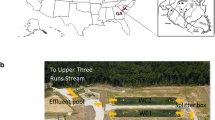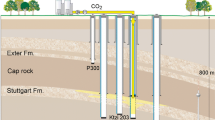Abstract
Laboratory storage of deep vadose zone sediments has previously resulted in an increase in the abundance of cultured microorganisms by as much as 10,000-fold, without concomitant increases in total microscopic counts. In the present study, factors contributing to the time-dependent stimulation of various microbiological parameters were examined during a 224 d post-sampling period, using a factorial-design experiment that partitioned the effects of storage time, sediment condition (intact blocks or homogenized) during storage, and O2 concentration (0.5, 4.5, and 21%) during storage at 15°C. Stored samples were analyzed at selected intervals, to determine direct microscopic counts, viable biomass, lipid biomarker profiles, cultured aerobic heterotrophic microorganisms, and microbial activity. Time of storage prior to analysis of the samples was the most important factor affecting the microbiological response. Sediment condition influenced the stimulation response: microbial activity and the population of cultured microorganisms increased faster, and reached slightly higher values, in the homogenized samples, although maximum values were reached at similar times in the homogenized and intact samples. O2 concentration also influenced the response, but was the least important of the factors evaluated. Total cells and viable biomass, measured as total phospholipid fatty acids, changed little during storage. Maximum cultured populations and activity were attained at 63 to 112 d, with culture counts approximating the total numbers of microscopically counted cells. At approximately the same time, unbalanced growth (evidenced by high ratios of polyhydroxybutyrate to phospholipid fatty acid) indicated that inorganic nutrients became limiting. Lipid biomarkers indicative of Gram-positive bacteria, including actinomycetes, became dominant components of the community profiles in samples maintained at 0.5% and 4.5% O2. The shift in the microbial community from relatively inactive, predominantly uncultured microorganisms to metabolically active populations that were nearly all cultured highlights the need for rapid initiation of analyses after sample acquisition, if measurement of in situ microbiological properties is desired. The fact that these processes also occur in intact sediment blocks suggests that minor perturbations in the chemical or physical properties of subsurface sediments can result in major changes in the activity and composition of the microbial community.
Similar content being viewed by others
Author information
Authors and Affiliations
Additional information
Revised: 22 October 1997; Accepted 20 November 1997
Rights and permissions
About this article
Cite this article
Brockman, F., Li, S., Fredrickson, J. et al. Post-Sampling Changes in Microbial Community Composition and Activity in a Subsurface Paleosol. Microb Ecol 36, 152–164 (1998). https://doi.org/10.1007/s002489900102
Issue Date:
DOI: https://doi.org/10.1007/s002489900102




